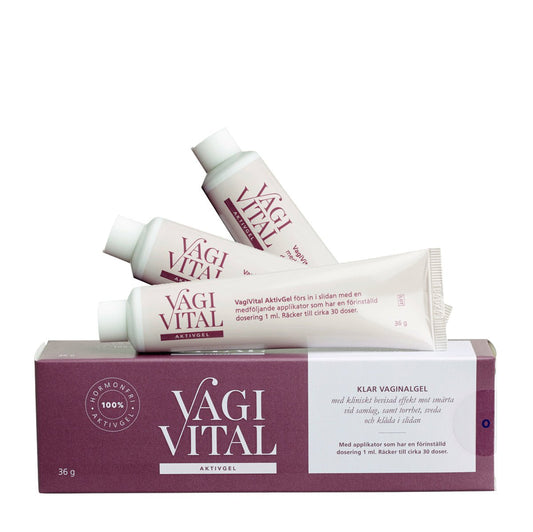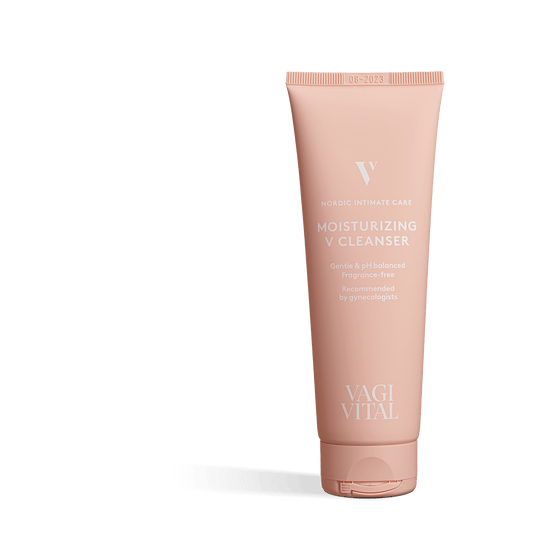Prolapse: Symptoms, causes, and treatment
There is an area within intimate health that has long been a blind spot for me – which probably means it has also been for many other women: prolapse.
One of the myths I have heard is that you shouldn't jog on asphalt because the "bounces" could cause prolapse. But is that really true? What does prolapse actually depend on? How do you notice that something is wrong? Can it be prevented? Are there different degrees of prolapse – and is it hereditary? And most importantly: what measures are available?
The more we know about our bodies, the easier it becomes to both take care of ourselves and break the silence – together ❤️
WHAT IS PROLAPSE?
Prolapse, or genital prolapse, means that one or more of the pelvic organs – such as the bladder, uterus, or rectum – descend and bulge into the vaginal wall. This is because the muscles and supporting tissue in the pelvic floor have weakened, making them no longer able to hold the organs in place.
It is much more common than we often think. According to Karolinska University Hospital, up to half of all women who have given birth suffer from some degree of prolapse, even though many do not have clear symptoms. At the same time, statistics show that about one in five women in Sweden undergo surgery for prolapse at some point in their lives.
COMMON SYMPTOMS
Symptoms of prolapse vary depending on which organ is affected and how far it has descended. Common signs are:
🌺 A feeling of heaviness or pressure in the genital area
🌺 A bulge in or outside the vaginal opening
🌺 Difficulty emptying the bladder or bowel completely
🌺 Involuntary urine leakage or urgency
🌺 Pain or discomfort during intercourse
🌺 Back pain or a feeling that something "bulges downward" after physical activity
Some women feel nothing at all, while others experience great discomfort. Many describe it as something "pushing out" in the vagina – sometimes so much that it feels like something is going to fall out of the body.
CAN YOU SEE A PROLAPSE YOURSELF?
Yes, in some cases – especially with a slightly higher degree of prolapse – you can actually detect it yourself with the help of a mirror. If you stand up, squat, or strain lightly, you can sometimes see a soft bulge in or outside the vaginal opening. It may look like a small bump or round tissue pressing against the opening. It is also common for the prolapse to be more visible at the end of the day or after physical exertion.
Looking at your genitals with a mirror is not only a way to see changes, but also a way to get to know your body ❤️.
But it is not always easy to determine for yourself what you see – and that is completely okay. If you are unsure or have symptoms such as a feeling of heaviness or pressure downwards, it is wise to contact a midwife or gynecologist with knowledge of the pelvic floor.
IS PROLAPSE DANGEROUS?
No, prolapse itself is rarely dangerous. It is not something that will rupture, break, or acutely damage the organs. But it can affect your quality of life – sometimes to a great extent. A feeling of pressure, discomfort, difficulty emptying the bladder or bowel, and impact on sex life are examples of symptoms that can grow over time if not taken seriously.
At the same time, it is also common to have a mild prolapse without feeling it at all. In mild grades (especially grade 1), the body can often compensate on its own, especially if you have good pelvic floor strength and do not strain the pelvic floor too much.
But if you suspect you have a prolapse – whether or not you have symptoms – it is wise to book a check-up with a midwife or gynecologist. Not because it is dangerous, but because you have the right to understand what is happening in your body, get the right advice and support – and because help is available if you need it.
DIFFERENT TYPES AND GRADES OF PROLAPSE
Prolapse is divided into different types depending on which organ descends:
🌸 Anterior prolapse (cystocele) – the bladder bulges against the vaginal wall
🌸 Posterior prolapse (rectocele) – the rectum presses against the back wall of the vagina
🌸 Uterine prolapse (uterus prolapse) – the uterus descends towards or out of the vaginal opening
🌸 Enterocele – the small intestine bulges into the upper part of the vagina, often after the uterus has been removed
Prolapse is graded from 1 to 4 – where grade 1 is a mild descent and grade 4 means the organ is completely outside the vagina.
WHAT CAUSES PROLAPSE?
The most common cause is a weakened pelvic floor, usually after one or more vaginal deliveries. But it is not the only factor. The risk also increases with:
🌺 Age and hormonal changes (especially after menopause)
🌺 Overweight
🌺 Heavy lifting in daily life or work
🌺 Chronic cough or constipation
🌺 Hereditary connective tissue weakness
A study from Sahlgrenska University Hospital shows that the risk of prolapse increases significantly after three or more vaginal deliveries, especially if these were prolonged, rapid, or involved the use of vacuum or forceps.
Jogging on asphalt does not cause prolapse by itself – but if the pelvic floor is already weakened, and is heavily strained without support from the muscles, some exercise (regardless of surface) can worsen the symptoms.
IS IT POSSIBLE TO PREVENT?
Yes, in many cases. Even if you cannot influence genetic factors or previous childbirths, there is much you can do to reduce the risk of developing or worsening a prolapse:
🌸 Practice pelvic floor exercises regularly – preferably with support from a physiotherapist
🌸 Avoid heavy lifting, or do it with the right technique
🌸 Keep the bowels balanced – avoid constipation and straining
🌸 Maintain a healthy weight
🌸 Quit smoking – chronic cough strains the pelvic floor
🌸 Strengthen and moisturize the mucous membranes in the genital area, especially after menopause
Moisturize and treat dry mucous membranes with VagiVital AktivGel.
Click here to buy
TREATMENT – WHAT CAN BE DONE?
Which treatment suits best depends on the degree of prolapse, your symptoms, and your own preferences. There are both non-surgical and surgical options:
1. Pelvic floor training
Regular pelvic floor exercises strengthen the muscles and can reduce symptoms in milder prolapse. It is a good foundation regardless of degree, and often the first step in treatment. According to research at the University of Gothenburg, regular pelvic floor training can not only reduce symptoms but also reduce the need for surgery in prolapse.
2. Pessary
A soft silicone aid that is placed in the vagina and provides support to the tissues. It is a hormone-free alternative suitable for many women – especially if you want to avoid or delay surgery.
3. Support for dry mucous membranes
When the mucous membranes become dry and fragile, which is common during and after menopause, it can increase the feeling of discomfort with prolapse. Some women then choose local estrogen treatment to strengthen the mucous membranes – but it is not the only option. VagiVital AktivGel is a hormone-free, medical device product that can be an equally good alternative. In clinical studies, AktivGel has shown equivalent effect to local estrogen treatment in treating dry mucous membranes – but without adding hormones.
4. Surgery
In cases of more pronounced discomfort, surgery may be considered. There are different methods depending on the type and degree of prolapse. A Swedish multicenter study from 2021 showed that the risk of recurrence after prolapse surgery is lower than previously thought – especially when women receive proper follow-up and support.
HOW IS A PROLAPSE SURGERY PERFORMED?
A surgery for prolapse aims to restore support for the organs that have descended into the vagina. Exactly how the procedure is done depends on the type of prolapse – for example, whether it is the bladder, rectum, or uterus – and how pronounced it is.
The surgery is usually done through the vagina, which means no incisions on the abdomen are needed. The weakened tissue is reinforced and stitched to give the organs better support. In some cases, it may be necessary to remove the uterus if it is part of the prolapse and other treatment options are insufficient – but this is far from always necessary and the decision is made in dialogue between patient and doctor.
The procedure is usually done under spinal anesthesia or general anesthesia. After a few days in hospital, a few weeks of recovery at home await, where you should avoid heavy lifting and follow the exercise advice you receive.
Many women experience a clear improvement after surgery, especially when they receive good information, rehabilitation, and follow-up – and where healthcare takes the whole person into account ❤️
DRY MUCUS MEMBRANES WITH PROLAPSE – WHAT CAN HELP?
Many women with prolapse are in menopause or postmenopause – and then dry, fragile mucous membranes are common. This can in itself worsen the feeling of discomfort, cause irritation, or affect sex life.
Although VagiVital AktivGel is not a treatment for prolapse, it can be a support for dry mucous membranes – regardless of whether it is due to hormonal changes, age, or other causes.
We have no studies that specifically examine AktivGel's effect on prolapse, but in our clinical studies AktivGel has shown equivalent effect to local hormone treatment for moisturizing dry mucous membranes. The gel is hormone-free and clinically tested at Swedish university hospitals.
"Good, easy to use!
If you have prolapse like me, the condition does not disappear with VagiVital AktivGel but the symptoms can be alleviated. Easy to use and economical if dosed correctly. Nice to avoid estrogen. Will continue to use Vagivital."
- Grandma
Try VagiVital Stay Pussytive kit - the ultimate kit to treat and moisturize dry mucous membranes – buy here
SUMMARY
Prolapse is common – but still something many women don't know much about. Perhaps because it has long been a topic we prefer to avoid. But it deserves to be highlighted. Because symptoms can be alleviated, support can be received, and you can feel safe in your body again.
Take care of yourself & Stay Pussytive ❤️
/Fanny Falkman Grinndal
Business Manager Nordics
Peptonic Medical AB
fanny.falkman-grinndal@peptonicmedical.se
Recommended products for you
- Choosing a selection results in a full page refresh.
- Opens in a new window.













